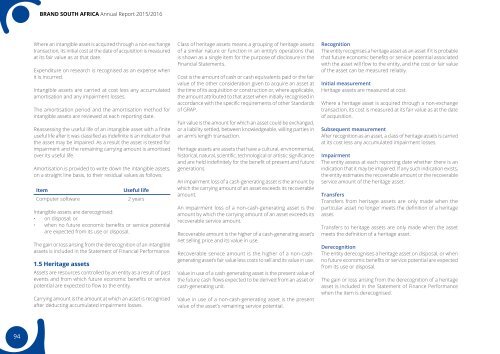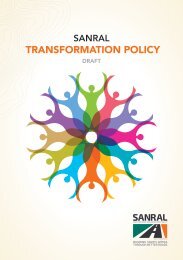Brand-South Africa - Annual report 2015 - 2016
During the past financial year, aligned with its mandate to build pride and patriotism in the Nation Brand, Brand South Africa has worked on initiatives to encourage active citizenship in partnership with its stakeholders in government, business, civil society and identified influential forums to increase the participation of all people, particularly our young people, in building a strong, cohesive Nation Brand. These activities, together with engagements at provincial level on Nation Brand alignment, contribute to social cohesion and a positive Nation Brand. Brand South Africa’s activities took place under the leadership of its new CEO, Amb. Kingsley Makhubela, PhD, who joined the organisation during the year.
During the past financial year, aligned with its mandate to build pride and patriotism in the Nation Brand, Brand South Africa has worked on initiatives to encourage active citizenship in partnership with its stakeholders in government, business, civil society and identified influential forums to increase the participation of all people, particularly our young people, in building a strong, cohesive Nation Brand. These activities, together with engagements at provincial level on Nation Brand alignment, contribute to social cohesion and a positive Nation Brand.
Brand South Africa’s activities took place under the leadership of its new CEO, Amb. Kingsley Makhubela, PhD, who joined the organisation during the year.
Create successful ePaper yourself
Turn your PDF publications into a flip-book with our unique Google optimized e-Paper software.
and south africa <strong>Annual</strong> Report <strong>2015</strong>/<strong>2016</strong><br />
Where an intangible asset is acquired through a non-exchange<br />
transaction, its initial cost at the date of acquisition is measured<br />
at its fair value as at that date.<br />
Expenditure on research is recognised as an expense when<br />
it is incurred.<br />
Intangible assets are carried at cost less any accumulated<br />
amortisation and any impairment losses.<br />
The amortisation period and the amortisation method for<br />
intangible assets are reviewed at each <strong>report</strong>ing date.<br />
Reassessing the useful life of an intangible asset with a finite<br />
useful life after it was classified as indefinite is an indicator that<br />
the asset may be impaired. As a result the asset is tested for<br />
impairment and the remaining carrying amount is amortised<br />
over its useful life.<br />
Amortisation is provided to write down the intangible assets,<br />
on a straight line basis, to their residual values as follows:<br />
Item<br />
Computer software<br />
Useful life<br />
2 years<br />
Intangible assets are derecognised:<br />
• on disposal; or<br />
• when no future economic benefits or service potential<br />
are expected from its use or disposal.<br />
The gain or loss arising from the derecognition of an intangible<br />
assets is included in the Statement of Financial Performance.<br />
1.5 Heritage assets<br />
Assets are resources controlled by an entity as a result of past<br />
events and from which future economic benefits or service<br />
potential are expected to flow to the entity.<br />
Carrying amount is the amount at which an asset is recognised<br />
after deducting accumulated impairment losses.<br />
Class of heritage assets means a grouping of heritage assets<br />
of a similar nature or function in an entity’s operations that<br />
is shown as a single item for the purpose of disclosure in the<br />
Financial Statements.<br />
Cost is the amount of cash or cash equivalents paid or the fair<br />
value of the other consideration given to acquire an asset at<br />
the time of its acquisition or construction or, where applicable,<br />
the amount attributed to that asset when initially recognised in<br />
accordance with the specific requirements of other Standards<br />
of GRAP.<br />
Fair value is the amount for which an asset could be exchanged,<br />
or a liability settled, between knowledgeable, willing parties in<br />
an arm’s length transaction.<br />
Heritage assets are assets that have a cultural, environmental,<br />
historical, natural, scientific, technological or artistic significance<br />
and are held indefinitely for the benefit of present and future<br />
generations.<br />
An impairment loss of a cash-generating asset is the amount by<br />
which the carrying amount of an asset exceeds its recoverable<br />
amount.<br />
An impairment loss of a non-cash-generating asset is the<br />
amount by which the carrying amount of an asset exceeds its<br />
recoverable service amount.<br />
Recoverable amount is the higher of a cash-generating asset’s<br />
net selling price and its value in use.<br />
Recoverable service amount is the higher of a non-cashgenerating<br />
asset’s fair value less costs to sell and its value in use.<br />
Value in use of a cash-generating asset is the present value of<br />
the future cash flows expected to be derived from an asset or<br />
cash-generating unit.<br />
Value in use of a non-cash-generating asset is the present<br />
value of the asset’s remaining service potential.<br />
Recognition<br />
The entity recognises a heritage asset as an asset if it is probable<br />
that future economic benefits or service potential associated<br />
with the asset will flow to the entity, and the cost or fair value<br />
of the asset can be measured reliably.<br />
Initial measurement<br />
Heritage assets are measured at cost.<br />
Where a heritage asset is acquired through a non-exchange<br />
transaction, its cost is measured at its fair value as at the date<br />
of acquisition.<br />
Subsequent measurement<br />
After recognition as an asset, a class of heritage assets is carried<br />
at its cost less any accumulated impairment losses.<br />
Impairment<br />
The entity assess at each <strong>report</strong>ing date whether there is an<br />
indication that it may be impaired. If any such indication exists,<br />
the entity estimates the recoverable amount or the recoverable<br />
service amount of the heritage asset.<br />
Transfers<br />
Transfers from heritage assets are only made when the<br />
particular asset no longer meets the definition of a heritage<br />
asset.<br />
Transfers to heritage assets are only made when the asset<br />
meets the definition of a heritage asset.<br />
Derecognition<br />
The entity derecognises a heritage asset on disposal, or when<br />
no future economic benefits or service potential are expected<br />
from its use or disposal.<br />
The gain or loss arising from the derecognition of a heritage<br />
asset is included in the Statement of Finance Performance<br />
when the item is derecognised.<br />
94











